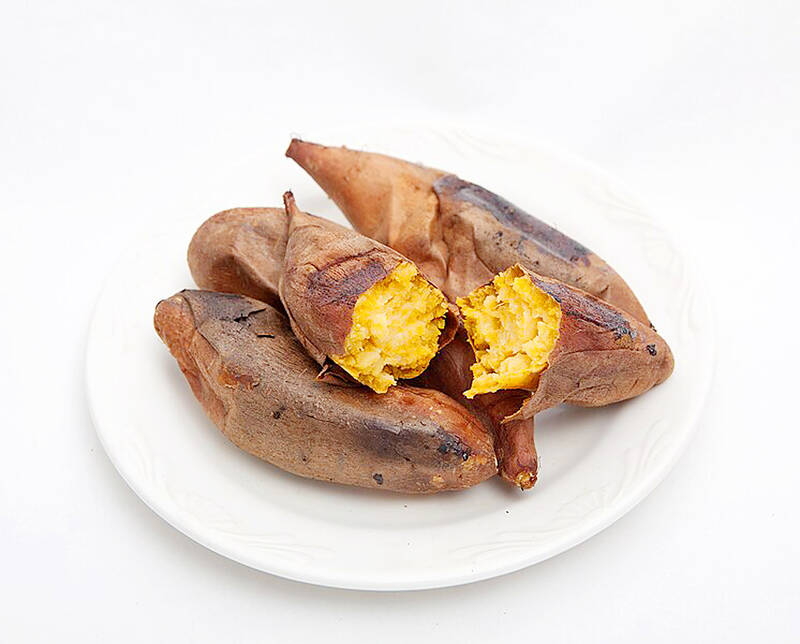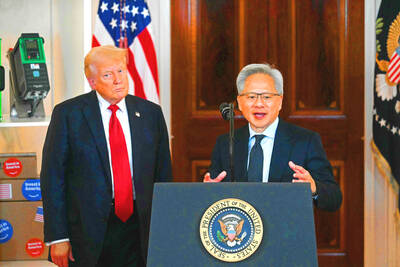It is often said that, to many Taiwanese, the shape of Taiwan resembles a sweet potato, a root vegetable that has fed countless Taiwanese people. Sweet potatoes are now usually eaten as part of a healthy diet and to lose weight, but to Taiwanese people in the early 20th century, they were an important food during difficult times. Sweet potatoes can grow well in infertile soils, whereas rice requires fertile soil and much water to grow. At that time, when many people could not afford a bowl of rice to eat, they often extended the rice by adding dried sweet potato shreds to the rice as it cooked, often with the final product having more sweet potato than rice. Other than being eaten as a staple food, sweet potatoes were often roasted as a snack during that time when people didn’t have many dessert options in their lives.
有人常形容台灣島外觀像番薯,番薯也餵飽無數的台灣人。現在人常為了養生和減重吃番薯,但在20 世紀初期,對台灣人來說,番薯是貧困時期賴以為生的重要食糧。有別於需要肥沃土壤的稻米,番薯在貧瘠的土地也能生長。當時許多人吃不起白米飯,於是將番薯刨成絲和米一起煮,甚至放得比米還要多。烤番薯也成了當時少有的點心之一。
root (n.) 塊根

Photo: Wiki Commons 照片: Wiki Commons
infertile (adj.) 不肥沃的
Roasting sweet potatoes is a simple task that doesn’t require much skill. Decades ago, it was not hard to find earth ovens made of rocks and dirt in the fields with roasted sweet potatoes inside. Once fully cooked, the sweet potato’s thick skin is easily peeled away to reveal a soft and sweet interior, providing a feeling of fullness and satisfaction that many Taiwanese senior citizens and middle-aged people cherish as a childhood memory.
烤地瓜不難,幾十年前田野間常看到烤番薯的土窯,烤好後就撕開厚厚的地瓜皮,裡面軟糯甜膩,頗有飽足感,是許多台灣長輩及中生代的童年回憶。
peel (v.) 剝去?皮
Even though we can now afford to eat rice every day, we still choose to eat sweet potatoes because they are both healthy and delicious. As more people become aware of the health benefits of sweet potatoes, such as aiding in weight loss, their popularity and price have increased. It’s fascinating to witness the transformation of sweet potatoes from being considered a vegetable associated with poverty to becoming a modern-day favorite for weight loss. They are now available in convenience stores to meet the growing demand for healthier and more convenient dietary options.
隨著人們經濟水準提升,人人都吃得起白米飯,番薯卻並未從我們的餐桌上消失。人們意識到番薯養生、有助於減重等好處,價格因此水漲船高,以前窮苦人家的食物,居然成為現代人的減重聖品。現在走進台灣便利商店就能買到烤番薯,提供顧客便利又健康的早餐選擇。
transformation (n.) 徹底改變
poverty (n.) 貧困,貧窮
dietary (adj.) 飲食的
Although many Taiwanese people have been eating sweet potatoes their entire lives, sweet potatoes are not native to Taiwan but were brought here in the 17th century. When General Cheng Cheng-kung’s army settled in Taiwan, the easily grown sweet potatoes provided sustenance for his troops. Without this important food source, Cheng’s army might have been unable to survive, which could have led to a very different outcome in Taiwan’s history.
台灣人雖然吃番薯吃了一輩子,但其實番薯不是台灣原生植物,17 世紀才引入台灣。鄭成功的軍隊開墾台灣時還努力耕種番薯,維持駐軍所需糧食,如果沒有番薯,台灣的歷史可能會重寫。
sustenance (n.) 食物,糧食
The sweet potato has become a symbol of resilience in Taiwan as it can grow even in challenging conditions. This association may have originated in the nicknames used to distinguish the local and Chinese armies after the Nationalist government relocated to Taiwan in 1949. The soldiers from China referred to the local Taiwanese as “sweet potato” and local Taiwanese called the Chinese soldiers “taro.” Today, sweet potatoes are an integral part of Taiwanese culture, not only as a dietary staple but also as a symbol of resilience and strength.
番薯因為在貧瘠的土壤也可以生長,成為適應力的代名詞。1949年國民政府遷台後,來到台灣的外省軍人,便稱「番薯」為「地瓜」,台灣人稱呼自己為「番薯」,並以「芋仔」來代稱外省軍人。因此,番薯之所以和台灣人密不可分,不只因為是主食,也因為象徵的台灣人堅忍不拔的精神。
resilience (n.) 適應力
文章由書林出版公司提供:
www.bookman.com.tw

Long before numerals and arithmetic systems developed, humans relied on tally marks to count. These simple, repeated marks — often just straight lines — are one of the earliest and most widespread methods of recording numbers. Archaeological findings suggest that humans began tallying in prehistoric times. During the Late Stone Age in Africa, humans began to carve notches onto bones to create tangible records of quantities. One of the earliest known examples is the Wolf bone, an artifact unearthed in Central Europe in 1937. This bone bears notches believed to be an early form of counting. Even more intriguing

A: In addition to Teng Kai-wei, Taiwanese infielder Cheng Tsung-che was called up temporarily to play for the Pittsburgh Pirates in early April. B: Yeah, Cheng is the 18th player in Taiwan’s baseball history to be moved up to the majors. A: Back in 2002, Chen Chin-feng became the first Taiwanese to play in the Major League Baseball (MLB), followed by Tsao Chin-hui, Wang Chien-ming, Kuo Hung-chih, Hu Chin-lung and Lin Che-hsuan. B: Those pioneers were later joined by Lo Chia-jen, C.C. Lee, Ni Fu-te, Chen Wei-yin, Wang Wei-chung, Hu Chih-wei, Tseng Jen-ho, Lin Tzu-wei, Huang Wei-chieh, Yu Chang,

When Nvidia CEO Jensen Huang revealed on Friday last week that the company is working with the Trump administration on a new computer chip designed for sale to China, it marked the latest chapter in a long-running debate over how the US should compete with China’s technological ambitions. The reasoning has sometimes changed — with US officials citing national security, human rights or purely economic competition — but the tool has been the same: export controls, or the threat of them. Nvidia believes it can eventually reap US$50 billion from artificial intelligence (AI) chip sales in China. But it so far has

Continued from yesterday(延續自昨日) https://www.taipeitimes.com/News/lang In many Western countries, the most common form of tally marks employs a five-bar gate structure: four vertical lines followed by a diagonal slash. To form this group, one begins by drawing four parallel vertical lines, each representing one. For the fifth, draw a diagonal line across the existing four. This diagonal stroke effectively creates a distinct group of five. To continue counting, just initiate a new cycle in the same manner. A set of five tallies combined with a single vertical line next to it represents the number six. Across many Asian countries, the Chinese character